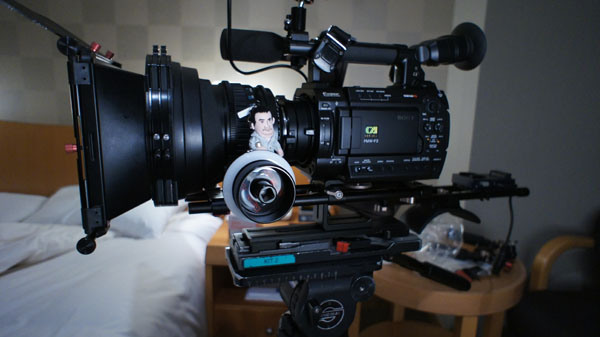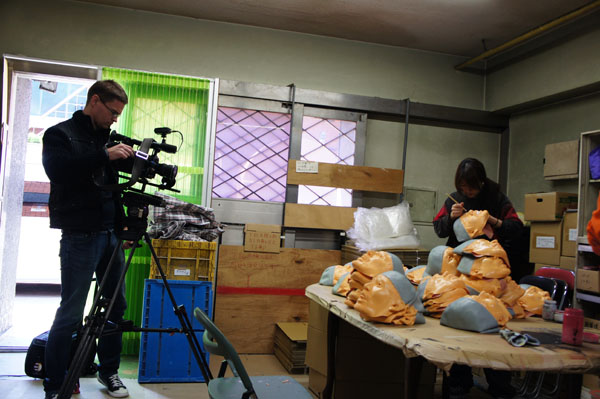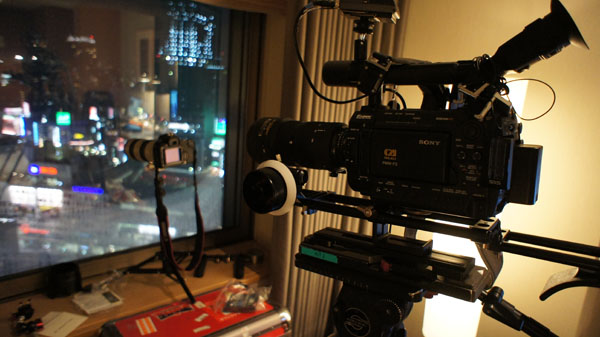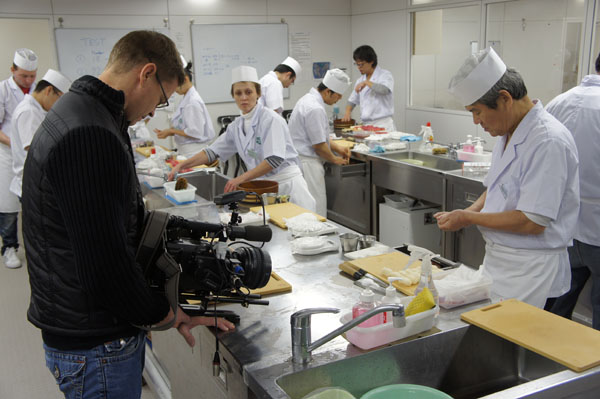
I have been shooting a lot over the last two years with Canon DSLRs. They have definitely changed the way I shoot and I’ve been able to use them in situations and conditions where I could never have used a HD broadcast camera.
I have been addicted to the brilliant image and low light capabilities that these cameras offer but at the same time have always struggled with the ergonomics, audio and slow turn around time of the footage. There have been improvements but there will always be small niggling problems for me when using a DSLR to shoot video.
I’m always on the look out for new forms of technology that make my job easier so I recently took the plunge and purchased a new Sony F3. I pre ordered my F3 in Japan and the camera turned up on the 1st Feb (unfortunately I couldn’t get back to Tokyo till the 25th Feb to pick it up.) I have the second one ever made (serial number 00002) as the store where I purchased it from (System 5) got the first production batch in the world. I chose to order the F3K which included three Sony made PL lenses (35mm, 50mm and 85mm T2). The lenses are terrific value and to my surprise are a lot easier and better to use than the pre production models I tested. The pre production models had very tight focus and iris rings but the production ones are very smooth. I will get into more detail about lenses a little later.
I have previously talked about the camera in an earlier article so I won’t go into too much detail about the specifications but I want to talk more about what it is like to use and what I think of the results.

I’m always optimistic about any new camera I get. I had watched lot of vision of the F3, read a lot of reviews and gone to a seminar launch in Japan. My initial reaction after turning the camera on and doing my first few shots with it was “Wow” this thing is unbelievable in low light. I never thought I’d ever pick up a camera where I was having to stop down so much because there was too much light. It was better than i was expecting. I mentioned to Dan Chung that I wasn’t expecting miracles with this camera. I have been very happy with the image out of the 5D mkII and the F3 certainly has a very different look to it than the DSLRs. It does look more like video on the standard settings and that’s because it is a video camera. The F3 is incredibly sharp on the standard settings and the detail is incredible. It can be made to look more like a 5D mkII but that requires a lot of tweaking and bringing the sharpness way down. The other thing that impressed me was the reproduction of skin tones. I have shot in both 25P and 50i. One of the main reasons i bought this camera was it’s ability to shoot 50i. People may be thinking why would you want to shoot in 50i? Well broadcast television news is almost entirely done in 50 or 60i. Once 25P is put on broadcast servers it tends to look terrible. It looks great on vimeo or your computer but it doesn’t look like that when it is broadcast. Don’t get me wrong I love progressive but my bread and butter jobs require me to shoot in 50i. I have not had much time to muck around with settings and try different looks as I have been in Japan on assignment and had to use the F3 almost straight away. I will endeavor to do more tests as soon as I can. The other brilliant thing about this camera is its ability to be able to stream live through the i-link firewire connector. This enables a computer to recognize the camera as a DV device. I do a lot of live crosses with my work so this is an important feature.
The F3 in terms of ease of use and operating is very similar to the Sony EX series of cameras. It took me very little time to get used to using it and operating the menus. There were a few things that are still a pain to use. The shutter can only be changed in the menu system (there is only a shutter on/of switch on the camera). The lack of EVF makes it very hard to use hand held but on the plus side the flip out LCD screen is very, very good. I had no problems judging exposure and finding focus. The peaking function is also very, very good and makes following focus very easy (one of the problems I always had with a 5D mkII).
Audio is very good and easy to use. It is so good to be able to have audio monitoring, headphone jack, dual XLR connectors and complete manual control.
As for lenses I have two different options at the moment. I have the three Sony PL mount lenses (which I believe are actually made by Zeiss) which are super sharp and have almost zero breathing. They are very fast T2 and when combined with a follow focus make pulling focus extremely smooth and a pleasure to use. The other lens option I have is using Nikon lenses with a MTF Nikon to F3 adaptor. This adaptor is brilliant and allows you to use any Nikon mount lens and be able to control the iris via the blue anodized ring (I will do a full review on the adaptor soon). My advice is that it is easier to either go all PL mount lenses or all stills lenses. The reason is because it takes time swapping the adaptors over. Changing lenses using just one adaptor is far quicker. So I either try and stick with the PL lenses or the stills lenses depending on the job. I have purchased a Tokina 11-16mm f2.8, Nikon 80-200mm f2.8 and a Zeiss 100mm Macro Planar f2.
I really didn’t see a massive change in the look of the image when using the different lenses. The PL mount Sony lenses are sharper and faster than the Nikon mount lenses I have and I prefer the look of them but saying that you don’t lose a lot by using stills lenses. In some cases the glass in good stills lenses is just as good as that found in PL lenses.
What would I recommend if you were thinking about purchasing this camera. Well I would definitely buy the included Sony PL lenses as they offer fantastic value for money. PL lenses are in high demand and you will still be able to re sell them at a high price in the future. You can’t buy these lenses except in the F3K kit. If you want to save money then buy a MTF adaptor (apart from Nikon there is also a Canon FD mount available and a Sony/Minolta one that is due out soon). You can buy good quality, cheap glass this way and have a lot more options for the type of lenses you can use. Also don’t be to worried about getting a super fast lens as this camera is so good in low light it will make just about any lens look good in bad lighting conditions. I still recommend buying fast glass because you can always use it on your DSLR as well.
Sony F3 vs Canon 5D Mark II Low Light Test from Matthew Allard on Vimeo.
The other night I had a spare ten minutes and did a very quick low light test comparing it to the 5D mkII. I wasn’t sure what to expect as I had heard early reports that it wasn’t as good as a 5D mkII in low light, but after speaking to a leading DOP in Japan who had thoroughly tested the camera in conjunction with Sony he and told me that the F3 was better in low light – hence I was optimistic. Both the cameras were on standard picture profiles, both on roughly the same focal length and both using similar lenses (Nikon 80-200mm f2.8 on the F3 and a 70-200mm IS f2.8 on the Canon 5D) and both on 1/60th shutter. I was amazed at how much better the F3 was than the 5D. I’m sure both cameras can be tweaked to perform even better so don’t take this test as gospel. I am also sure after writing this I will get a legion of 5D mkII users writing in to complain that its not a accurate test. I am an avid user of the 5D mkII and love its abilities in low light but from actually using the F3 in the real world it blew me away with the sort of conditions I could shoot in.

Even though the F3 was shooting on SxS cards at 35mb/s I have been very surprised by the image quality. The seminar I had previously attended in Tokyo had demonstrated footage of the same scene shot on 35mb/s and at 220mb/s Apple ProRes 422 and they blew up part of the image to 400%. There was barely any difference between the two.
I also have been lucky enough to get hold of a Cinedeck Extreme to test. This is simply a awesome all-in-one recorder, monitor, with full play back capabilities that will capture in all of the Apple ProRes codecs, Avid’s DNx HD, and Cineform. It has dual HD SDI inputs, HDMI inputs and also offers full audio/video monitoring, and all the scopes you could ever want. It records to SSD drives so the device can be taken off the camera and plugged straight into your computer. This is the same device used on Danny Boyle’s latest movie 127 hours. Again I will have a full review of it soon.
So my over all impressions of the camera so far are fantastic. I am very, very happy with what it does and the image quality is superb. If you are looking for something that looks like a DSLR then it is probably not for you. You can still get amazing results with a 5D mkII but for the type of work I do this camera is sensational. I recommend it to anyone shooting feature style news stories, documentaries and indy films. It is definitely not a camera for someone who doesn’t make their living in the world of film or television. If it’s just a hobby for you or a passion, stick with a DSLR as it offers incredible results at a fraction of the price.
About Matthew Allard, Aljazeera Senior Field Cameraman, Kuala Lumpur:
Matt has been a Camera/Editor in TV news for 20 years, previously working for both Channel 9 and Channel 10 in Australia. Twice Network Ten Australia’s cameraman of the year as well as being a Walkley Finalist for outstanding camerawork in 2006 (for coverage of the Cronulla Race Riots) and a Logie Finalist for outstanding news coverage 2006 (Bali 9). He has covered news events in more than 30 countries, from major sporting events to terrorist bombings. Based out of the Kuala Lumpur broadcast centre in Malaysia he is an avid user and follower of new technology, shooting stories on HD broadcast cameras as well as new Canon DSLR’s.







